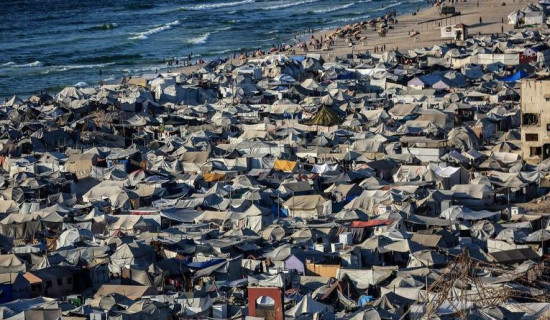- Monday, 8 September 2025
Beware Of Nairobi Fly Dermatitis
Uttam Maharjan
Nairobi fly dermatitis has recently appeared in the Terai districts of Nepal. The disease has spread from Africa to India and from there to Nepal. As Nepal and India have porous borders with a lot of movement of people from one country to the other, the disease has quickly infected Nepalis living in the Terai region. Nairobi fly dermatitis is caused by small rove beetles called Nairobi flies or Kenyan flies. The main culprits are two species: Paederus eximius and P. sabaeus. These species belong to the coleopteran family Staphylinidae. Nairobi flies are conspicuous by their red/orange and black colour. They thrive in moist environments where much rain occurs.
Nairobi flies are attracted to bright lights. They do not bite or sting but when they sit on the skin of a person, they release a potent corrosive substance called pederin that causes chemical burns. There are around 600 species of Paederus but only 20 species can cause such burns. Pederin is contained in the haemolymph (blood) of the insects. The acidic substance can cause blistering and a skin irritation leading to Nairobi fly dermatitis. This fly is medically known as dermatitis linearis.
Blistering chemicals
The coelomic fluid of Nairobi flies contains strong blistering chemicals, which are known as vesicants. The active agent in the fluid is called pederin. Depending on the species of beetles, the coelomic fluid may contain pederone or pseudopederin. There is a similar disease called blister beetle dermatitis. The disease is caused by cantharidin, a vesicant produced by blister beetles. The vesicant can get into the skin if a blister beetle is touched. The term “blister beetle dermatitis” is sometimes used to describe paederus dermatitis caused by rove beetles.
When humans come into contact with Nairobi flies and they land on their skin, there will be no immediate irritation or other signs. Within 12 to 36 hours, a reddish rash called erythema will surface, which will develop into blisters. A swollen skin and serious skin damage may also be produced. There will also emerge lesions, unusual marks and discolouration on the skin. Kissing or mirror-image lesions will appear on the interface of two skin areas. Irritation, including crusting and scaling, will emerge in two or three weeks.
After the skin heals over in one or two weeks, secondary infections may ensue if the skin is scratched. Pederin can spread to other parts of the body such as the eyes and the genitals. Pederin is considered more potent than cobra venom. When the eyes are infected, it is called Nairobi eye. Nairobi eye, a form of conjunctivitis, can lead to temporary blindness. This term is used in eastern Africa.
In fact, the severity of the disease depends on individual cases, the dose of pederin and the duration of contact. In a mild case, a slight redness of the skin will arise. In a moderate case, itching will start after 24 hours and blistering will appear within 48 hours. Such blisters usually dry out with no scars left. In a more severe case, the victim will suffer fever, nerve pains, joint paints and vomiting. Healing can occur from one week to four weeks, usually with permanent skin discolouration.
Nairobi flies are not only harmful; they are beneficial to agriculture as they attack crop-destroying pests. Preliminary research on mice shows that pederin has potential for slowing the growth of cancerous tumours. Further research on pederin, the bacteria of the genus Pseudomonas that produce pederin and Paederus beetles, needs to be accelerated to discover anti-cancer treatment. Moreover, evolutionary relationships between Paederus beetles is not well known. Figuring out where and how to look for pederin among hundreds of described and undescribed species would be a stepping stone towards understanding the evolutionary relationships.
Nairobi fly dermatitis has occurred, especially in Asia and Europe. However, it has also occurred in other parts of the world. Countries such as France, Kenya, Nigeria, Ethiopia, Sierra Leone, Uganda, Central Africa, Malaysia, Indonesia, Thailand, Singapore, Taiwan, Vietnam, Sri Lanka, India, Japan, Israel, Australia, Venezuela, Ecuador, Brazil and Paraguay have reported the incidence of the disease. Major outbreaks have occurred in Kenya and other parts of eastern Africa. Outbreaks occurred in 1998, 2007, 2019 and 2020. In 1998, heavy rain encouraged a large number of Nairobi flies to swarm across Kenya and other parts of eastern Africa, thus inducing outbreaks.
Alertness
As Nairobi fly dermatitis has appeared in Nepal, it would be prudent to maintain alertness to Nairobi flies. These flies attack people at night. They thrive in the rainy season because their breeding period falls in the rainy season. When they sit on the skin, they should not be crushed or squashed. Doing this will make them release pederin. So they should be gently brushed off. And the affected part of the body should not touch other parts such as the eyes. The affected part should be washed with soap and water.
As Nairobi flies are attracted to lights, we should not sit under lights at night. We should wear full-sleeve clothes and use mosquito nets to keep these flies at bay. If pederin has penetrated the skin, we should visit the doctor.
The treatment regime for Nairobi fly dermatitis includes rapidly washing the affected part of the body with soap and water, applying cold, wet compresses on the affected part, applying calamine lotion on the affected part or treating the disease with topical steroids with antihistamines and antibiotics. The use of steroids, antihistamines and antibiotics has produced desired results.
(Maharjan has been regularly writing on contemporary issues for this daily since 2000. uttam.maharjan1964@gmail.com)









-original-thumb.jpg)



-original-thumb.jpg)


